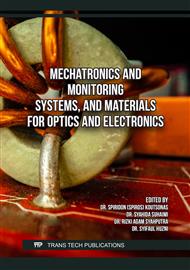[1]
A. K. Rajan and L. Cindrella, "Studies on new natural dye sensitizers from Indigofera tinctoria in dye-sensitized solar cells," Opt Mater (Amst), vol. 88, no. September 2018, p.39–47, 2019.
DOI: 10.1016/j.optmat.2018.11.016
Google Scholar
[2]
R. Syafinar, N. Gomesh, M. Irwanto, M. Fareq, and Y. M. Irwan, Potential of Purple Cabbage, Coffee, Blueberry and Turmeric as Nature Based Dyes for Dye Sensitized Solar Cell (DSSC), vol. 79. Elsevier B.V., 2015.
DOI: 10.1016/j.egypro.2015.11.569
Google Scholar
[3]
S. Shalini, R. Balasundara Prabhu, S. Prasanna, T. K. Mallick, and S. Senthilarasu, "Review on natural dye sensitized solar cells: Operation, materials and methods," Renewable and Sustainable Energy Reviews, vol. 51, p.1306–1325, 2015.
DOI: 10.1016/j.rser.2015.07.052
Google Scholar
[4]
M. Bhogaita, A. D. Shukla, and R. P. Nalini, "Recent advances in hybrid solar cells based on natural dye extracts from Indian plant pigment as sensitizers," Solar Energy, vol. 137, p.212–224, 2016.
DOI: 10.1016/j.solener.2016.08.003
Google Scholar
[5]
A. D. Zikri and J. Gunlazuardi, "Preparation of a TiO2-based dye-sensitized solar cell comprising anthocyanin from mangosteen pericarp (Garcinia mangostana, L.) as the sensitizer: Co-pigmentation effect on sensitizer and solar cell efficiency," J Phys Conf Ser, vol. 1442, no. 1, 2020.
DOI: 10.1088/1742-6596/1442/1/012062
Google Scholar
[6]
A. Bist and S. Chatterjee, "Review on Efficiency Enhancement Using Natural Extract Mediated Dye-Sensitized Solar Cell for Sustainable Photovoltaics," Aug. 01, 2021, John Wiley and Sons Inc.
DOI: 10.1002/ente.202001058
Google Scholar
[7]
R. Nur Iman, M. Younas, K. Harrabi, and A. Mekki, "A comprehensive review on advancements and optimization strategies in dye-sensitized solar cells: Components, characterization, stability and efficiency enhancement," Inorg Chem Commun, vol. 165, no. April, p.112488, 2024.
DOI: 10.1016/j.inoche.2024.112488
Google Scholar
[8]
G. Calogero, J. H. Yum, A. Sinopoli, G. Di Marco, M. Grätzel, and M. K. Nazeeruddin, "Anthocyanins and betalains as light-harvesting pigments for dye-sensitized solar cells," Solar Energy, vol. 86, no. 5, p.1563–1575, 2012.
DOI: 10.1016/j.solener.2012.02.018
Google Scholar
[9]
N. A. M. Arifin, H. Salleh, A. N. Dagang, N. A. N. Ali, N. S. Alias, and N. H. Kamarulzaman, "Photodegradation effect on optical properties of mangosteen pericarp, black grape peel and violet bougainvillea flowers as photosensitizer for solar cell application," J Teknol, vol. 83, no. 5, p.109–117, 2021.
DOI: 10.11113/jurnalteknologi.v83.16729
Google Scholar
[10]
K. Sharma, V. Sharma, and S. S. Sharma, "Dye-Sensitized Solar Cells: Fundamentals and Current Status," Nanoscale Res Lett, vol. 13, 2018.
DOI: 10.1186/s11671-018-2760-6
Google Scholar
[11]
J. M. R. C. Fernando and G. K. R. Senadeera, "Natural anthocyanins as photosensitizers for dye-sensitized solar devices," Curr Sci, vol. 95, no. 5, p.663–666, 2008, [Online]. Available: https://www.jstor.org/stable/24102808
Google Scholar
[12]
N. Sofyan, A. Ridhova, A. H. Yuwono, and A. Udhiarto, "Fabrication of solar cells with TiO2 nanoparticles sensitized using natural dye extracted from mangosteen pericarps," International Journal of Technology, vol. 8, no. 7, p.1229–1238, 2017.
DOI: 10.14716/ijtech.v8i7.692
Google Scholar


